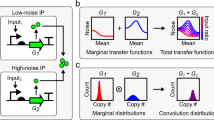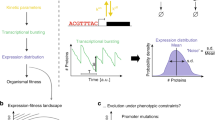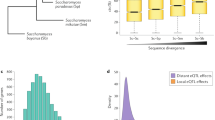Abstract
The genetic circuits that regulate cellular functions are subject to stochastic fluctuations, or ‘noise’, in the levels of their components. Noise, far from just a nuisance, has begun to be appreciated for its essential role in key cellular activities. Noise functions in both microbial and eukaryotic cells, in multicellular development, and in evolution. It enables coordination of gene expression across large regulons, as well as probabilistic differentiation strategies that function across cell populations. At the longest timescales, noise may facilitate evolutionary transitions. Here we review examples and emerging principles that connect noise, the architecture of the gene circuits in which it is present, and the biological functions it enables. We further indicate some of the important challenges and opportunities going forward.
This is a preview of subscription content, access via your institution
Access options
Subscribe to this journal
Receive 51 print issues and online access
$199.00 per year
only $3.90 per issue
Buy this article
- Purchase on Springer Link
- Instant access to full article PDF
Prices may be subject to local taxes which are calculated during checkout




Similar content being viewed by others
References
Maheshri, N. & O’Shea, E. K. Living with noisy genes: how cells function reliably with inherent variability in gene expression. Annu. Rev. Biophys. Biomol. Struct. 36, 413–434 (2007)
Raj, A. & van Oudenaarden, A. Nature, nurture, or chance: stochastic gene expression and its consequences. Cell 135, 216–226 (2008)
Locke, J. & Elowitz, M. Using movies to analyse gene circuit dynamics in single cells. Nature Rev. Microbiol. 7, 383–392 (2009)
Davidson, C. & Surette, M. Individuality in bacteria. Annu. Rev. Genet. 42, 253–268 (2008)
Losick, R. & Desplan, C. Stochasticity and cell fate. Science 320, 65–68 (2008)
Lestas, I., Vinnicombe, G. & Paulsson, J. Fundamental limits on the suppression of molecular fluctuations. Nature 10.1038/nature09333 (this issue)
McAdams, H. H. & Arkin, A. Stochastic mechanisms in gene expression. Proc. Natl Acad. Sci. USA 94, 814–819 (1997)
Friedman, N., Cai, L. & Xie, X. Linking stochastic dynamics to population distribution: an analytical framework of gene expression. Phys. Rev. Lett. 97, 168302 (2006)
Paulsson, J. Summing up the noise in gene networks. Nature 427, 415–418 (2004)
Paulsson, J., Berg, O. & Ehrenberg, M. Stochastic focusing: fluctuation-enhanced sensitivity of intracellular regulation. Proc. Natl Acad. Sci. USA 97, 7148 (2000)
Golding, I., Paulsson, J., Zawilski, S. M. & Cox, E. C. Real-time kinetics of gene activity in individual bacteria. Cell 123, 1025–1036 (2005)
Yu, J., Xiao, J., Ren, X., Lao, K. & Xie, X. S. Probing gene expression in live cells, one protein molecule at a time. Science 311, 1600–1603 (2006)
Cai, L., Friedman, N. & Xie, X. S. Stochastic protein expression in individual cells at the single molecule level. Nature 440, 358–362 (2006)
Ozbudak, E. M., Thattai, M., Kurtser, I., Grossman, A. D. & van Oudenaarden, A. Regulation of noise in the expression of a single gene. Nature Genet. 31, 69–73 (2002)
Zenklusen, D., Larson, D. R. & Singer, R. H. Single-RNA counting reveals alternative modes of gene expression in yeast. Nature Struct. Mol. Biol. 15, 1263–1271 (2008)
Blake, W. J., KÆrn, M., Cantor, C. R. & Collins, J. J. Noise in eukaryotic gene expression. Nature 422, 633–637 (2003)
Raj, A., Peskin, C., Tranchina, D., Vargas, D. & Tyagi, S. Stochastic mRNA synthesis in mammalian cells. PLoS Biol. 4, e309 (2006)
Paré, A. et al. Visualization of individual Scr mRNAs during Drosophila embryogenesis yields evidence for transcriptional bursting. Curr. Biol. 19, 2037–2042 (2009)
Dunlop, M., Cox, R., III, Levine, J., Murray, R. & Elowitz, M. Regulatory activity revealed by dynamic correlations in gene expression noise. Nature Genet. 40, 1493–1498 (2008)
Cox, C., McCollum, J., Allen, M., Dar, R. & Simpson, M. Using noise to probe and characterize gene circuits. Proc. Natl Acad. Sci. USA 105, 10809–10814 (2008)
Rosenfeld, N., Young, J. W., Alon, U., Swain, P. S. & Elowitz, M. B. Gene regulation at the single-cell level. Science 307, 1962–1965 (2005)
Sigal, A. et al. Variability and memory of protein levels in human cells. Nature 444, 643–646 (2006)
Elowitz, M. B., Levine, A. J., Siggia, E. D. & Swain, P. S. Stochastic gene expression in a single cell. Science 297, 1183–1186 (2002)
Bar-Even, A. et al. Noise in protein expression scales with natural protein abundance. Nature Genet. 38, 636–643 (2006)
Newman, J. et al. Single-cell proteomic analysis of S. cerevisiae reveals the architecture of biological noise. Nature 441, 840–846 (2006)
Cai, L., Dalal, C. K. & Elowitz, M. B. Frequency-modulated nuclear localization bursts coordinate gene regulation. Nature 455, 485–490 (2008)This paper reports that the yeast calcium-response system uses frequency modulation of stochastic nuclear localization bursts of the Crz1 transcription factor to enable coordination (proportional expression) across large regulons.
Cyert, M. Genetic analysis of calmodulin and its targets in Saccharomyces cerevisiae . Annu. Rev. Genet. 35, 647–672 (2001)
Shankaran, H. et al. Rapid and sustained nuclear–cytoplasmic ERK oscillations induced by epidermal growth factor. Mol. Syst. Biol. 5 332 10.1038/msb.2009.90 (2009)
Thattai, M. & van Oudenaarden, A. Stochastic gene expression in fluctuating environments. Genetics 167, 523–530 (2004)
Kussell, E. & Leibler, S. Phenotypic diversity, population growth, and information in fluctuating environments. Science 309, 2075–2078 (2005)
Wolf, D., Vazirani, V. & Arkin, A. Diversity in times of adversity: probabilistic strategies in microbial survival games. J. Theor. Biol. 234, 227–253 (2005)
Acar, M., Mettetal, J. T. & van Oudenaarden, A. Stochastic switching as a survival strategy in fluctuating environments. Nature Genet. 40, 471–475 (2008)A synthetic study demonstrating that the rate of stochastic switching between phenotypic states is optimized when it matches the rate of environmental fluctuations.
Balaban, N. Q., Merrin, J., Chait, R., Kowalik, L. & Leibler, S. Bacterial persistence as a phenotypic switch. Science 305, 1622–1625 (2004)
Gardner, T. S., Cantor, C. R. & Collins, J. J. Construction of a genetic toggle switch in Escherichia coli . Nature 403, 339–342 (2000)
Kashiwagi, A., Urabe, I., Kaneko, K. & Yomo, T. Adaptive response of a gene network to environmental changes by fitness-induced attractor selection. PLoS ONE 1, e49 (2006)
To, T. & Maheshri, N. Noise can induce bimodality in positive transcriptional feedback loops without bistability. Science 327, 1142 (2010)
Novick, A. & Weiner, M. Enzyme induction as an all-or-none phenomenon. Proc. Natl Acad. Sci. USA 43, 553–566 (1957)
Benzer, S. Induced synthesis of enzymes in bacteria analyzed at the cellular level. Biochim. Biophys. Acta 11, 383–395 (1953)
Ozbudak, E. M., Thattai, M., Lim, H. N., Shraiman, B. I. & Van Oudenaarden, A. Multistability in the lactose utilization network of Escherichia coli . Nature 427, 737–740 (2004)
Choi, P. J., Cai, L., Frieda, K. & Xie, X. S. A stochastic single-molecule event triggers phenotype switching of a bacterial cell. Science 322, 442–446 (2008)This detailed analysis of stochastic state transitions in the lac operon identified stochastic promoter state switching as the origin of phenotypic changes in E. coli.
Elf, J., Li, G. W. & Xie, X. S. Probing transcription factor dynamics at the single-molecule level in a living cell. Science 316, 1191–1194 (2007)
Boeger, H., Griesenbeck, J. & Kornberg, R. D. Nucleosome retention and the stochastic nature of promoter chromatin remodeling for transcription. Cell 133, 716–726 (2008)
Degenhardt, T. et al. Population-level transcription cycles derive from stochastic timing of single-cell transcription. Cell 138, 489–501 (2009)
Sharma, S. et al. A chromatin-mediated reversible drug-tolerant state in cancer cell subpopulations. Cell 141, 69–80 (2010)A small sub-population resists drug treatment with no genetic variability. Specific inhibitors eliminate the resistant sub-population while keeping the larger sensitive population.
Maamar, H. & Dubnau, D. Bistability in the Bacillus subtilis K-state (competence) system requires a positive feedback loop. Mol. Microbiol. 56, 615–624 (2005)
Süel, G. M., Garcia-Ojalvo, J., Liberman, L. M. & Elowitz, M. B. An excitable gene regulatory circuit induces transient cellular differentiation. Nature 440, 545–550 (2006)
Süel, G. M., Kulkarni, R. P., Dworkin, J., Garcia-Ojalvo, J. & Elowitz, M. B. Tunability and noise dependence in differentiation dynamics. Science 315, 1716–1719 (2007)
Maamar, H., Raj, A. & Dubnau, D. Noise in gene expression determines cell fate in Bacillus subtilis . Science 317, 526–529 (2007)By reciprocally perturbing transcription and translation rates, the authors showed that noise in the expression of a master transcription factor directly regulates the frequency of differentiation into the competent state.
Di Talia, S., Skotheim, J., Bean, J., Siggia, E. & Cross, F. The effects of molecular noise and size control on variability in the budding yeast cell cycle. Nature 448, 947–951 (2007)
Çağatay, T., Turcotte, M., Elowitz, M., Garcia-Ojalvo, J. & Süel, G. M. Architecture-dependent noise discriminates functionally analogous differentiation circuits. Cell 139, 512–522 (2009)Two seemingly equivalent architectures for the competence transient differentiation system differ principally in their variability, with the wild-type version more sensitive to noise, enhancing the range of environments in which the system can function.
Veening, J. W. et al. Bet-hedging and epigenetic inheritance in bacterial cell development. Proc. Natl Acad. Sci. USA 105, 4393–4398 (2008)
Fujita, M. & Losick, R. Evidence that entry into sporulation in Bacillus subtilis is governed by a gradual increase in the level and activity of the master regulator Spo0A. Genes Dev. 19, 2236–2244 (2005)
Nachman, I., Regev, A. & Ramanathan, S. Dissecting timing variability in yeast meiosis. Cell 131, 544–556 (2007)
Spencer, S. L., Gaudet, S., Albeck, J. G., Burke, J. M. & Sorger, P. K. Non-genetic origins of cell-to-cell variability in TRAIL-induced apoptosis. Nature 459, 428–432 (2009)
Suda, T., Suda, J. & Ogawa, M. Single-cell origin of mouse hemopoietic colonies expressing multiple lineages in variable combinations. Proc. Natl Acad. Sci. USA 80, 6689 (1983)
Shah, N., Groves, A. & Anderson, D. Alternative neural crest cell fates are instructively promoted by TGFβ superfamily members. Cell 85, 331–343 (1996)
Chazaud, C., Yamanaka, Y., Pawson, T. & Rossant, J. Early lineage segregation between epiblast and primitive endoderm in mouse blastocysts through the Grb2-MAPK pathway. Dev. Cell 10, 615–624 (2006)
Dietrich, J. E. & Hiiragi, T. Stochastic patterning in the mouse pre-implantation embryo. Development 134, 4219–4231 (2007)
Yamanaka, Y., Lanner, F. & Rossant, J. FGF signal-dependent segregation of primitive endoderm and epiblast in the mouse blastocyst. Development 137, 715–724 (2010)
Morris, S. A. et al. Origin and formation of the first two distinct cell types of the inner cell mass in the mouse embryo. Proc. Natl Acad. Sci. USA 107, 6364–6369 (2010)The above two references show that differentiation in the early mouse embryo seems to occur through a stochastic process with a lineage bias, supporting the stochastic sorting model of patterning.
Kay, R. R. & Thompson, C. R. L. Forming patterns in development without morphogen gradients: scattered differentiation and sorting out. Cold Spring Harb. Perspect. Biol. 1 10.1101/cshperspect.a001503 (2009)
Singh, A. M., Hamazaki, T., Hankowski, K. E. & Terada, N. A heterogeneous expression pattern for Nanog in embryonic stem cells. Stem Cells 25, 2534–2542 (2007)
Chambers, I. et al. Nanog safeguards pluripotency and mediates germline development. Nature 450, 1230–1234 (2007)
Kalmar, T. et al. Regulated fluctuations in nanog expression mediate cell fate decisions in embryonic stem cells. PLoS Biol. 7, e1000149 (2009)
Chang, H., Hemberg, M., Barahona, M., Ingber, D. & Huang, S. Transcriptome-wide noise controls lineage choice in mammalian progenitor cells. Nature 453, 544 (2008)
Canham, M. A., Sharov, A. A., Ko, M. S. H. & Brickman, J. M. Functional heterogeneity of embryonic stem cells revealed through translational amplification of an early endodermal transcript. PLoS Biol. 8, e1000379 (2010)
Hill, W. & Zhang, X. Effects on phenotypic variability of directional selection arising through genetic differences in residual variability. Genet. Res. 83, 121–132 (2004)
Ito, Y., Toyota, H., Kaneko, K. & Yomo, T. How selection affects phenotypic fluctuation. Mol. Syst. Biol. 5 10.1038/msb.2009.23 (2009)
Raj, A., Rifkin, S., Andersen, E. & van Oudenaarden, A. Variability in gene expression underlies incomplete penetrance. Nature 463, 913–918 (2010)
Queitsch, C., Sangster, T. A. & Lindquist, S. Hsp90 as a capacitor of phenotypic variation. Nature 417, 618–624 (2002)
Eldar, A. et al. Partial penetrance facilitates developmental evolution in bacteria. Nature 460, 510–514 (2009)Single-cell analysis of a bacterial developmental pathway reveals how new morphologies can be produced at low penetrance and then stabilized by additional mutations, providing a gradual pathway for discrete evolutionary transitions.
Angert, E. R. Alternatives to binary fission in bacteria. Nature Rev. Microbiol. 3, 214–224 (2005)
Mehta, P., Goyal, S. & Wingreen, N. A quantitative comparison of sRNA-based and protein-based gene regulation. Mol. Syst. Biol. 4 10.1038/msb.2008.58 (2008)
Levine, E., Zhang, Z., Kuhlman, T. & Hwa, T. Quantitative characteristics of gene regulation by small RNA. PLoS Biol. 5, e229 (2007)
Valdeolmillos, M., Gomis, A. & Sanchez-Andres, J. In vivo synchronous membrane potential oscillations in mouse pancreatic β-cells: lack of co-ordination between islets. J. Physiol. (Lond.) 493, 9–15 (1996)
Tang, F. et al. mRNA-Seq whole-transcriptome analysis of a single cell. Nature Methods 6, 377–382 (2009)
Beaumont, H., Gallie, J., Kost, C., Ferguson, G. & Rainey, P. Experimental evolution of bet hedging. Nature 462, 90–93 (2009)
Snijder, B. et al. Population context determines cell-to-cell variability in endocytosis and virus infection. Nature 461, 520–523 (2009)
Acknowledgements
We thank G. Süel, A. Raj, F. Tan and J. Rossant for providing images. We thank N. Wingreen, D. J. Anderson, R. Kishony, J.-G. Ojalvo, G. Süel, H. Y. Kueh and members of the Elowitz laboratory for discussions. Work in M.B.E.’s laboratory was supported by NIH grants R01GM079771, P50 GM068763, NSF CAREER Award 0644463 and the Packard Foundation. A.E. was supported by EMBO, the International Human Frontier Science Organization and a Baxter fellowship.
Author information
Authors and Affiliations
Corresponding author
Ethics declarations
Competing interests
The authors declare no competing financial interests.
Rights and permissions
About this article
Cite this article
Eldar, A., Elowitz, M. Functional roles for noise in genetic circuits. Nature 467, 167–173 (2010). https://doi.org/10.1038/nature09326
Issue Date:
DOI: https://doi.org/10.1038/nature09326
This article is cited by
-
Flagellar dynamics reveal fluctuations and kinetic limit in the Escherichia coli chemotaxis network
Scientific Reports (2023)
-
Dynamic fluctuations in a bacterial metabolic network
Nature Communications (2023)
-
Molecular versatility during pluripotency progression
Nature Communications (2023)
-
Employing active learning in the optimization of culture medium for mammalian cells
npj Systems Biology and Applications (2023)
-
The epithelial–mesenchymal plasticity landscape: principles of design and mechanisms of regulation
Nature Reviews Genetics (2023)
Comments
By submitting a comment you agree to abide by our Terms and Community Guidelines. If you find something abusive or that does not comply with our terms or guidelines please flag it as inappropriate.



